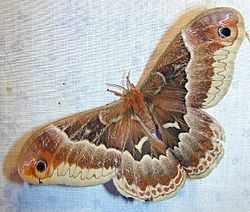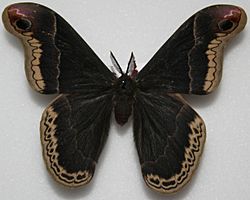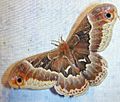Promethea silkmoth facts for kids
Quick facts for kids Promethea Silkmoth |
|
|---|---|
 |
|
| Female | |
 |
|
| Male | |
| Scientific classification | |
| Kingdom: | |
| Phylum: | |
| Class: | |
| Order: | |
| Superfamily: |
Bombycoidea
|
| Family: | |
| Subfamily: |
Saturniinae
|
| Tribe: |
Attacini
|
| Genus: |
Callosamia
|
| Species: |
C. promethea
|
| Binomial name | |
| Callosamia promethea |
|
The Promethea Moth (Callosamia promethea) is a type of moth. It is part of the family called Saturniidae. You might also hear it called the Promethea Silkmoth or the Spicebush Silkmoth.
Contents
What the Promethea Moth Looks Like
The male Promethea Moth has dark brownish-black wings. A faint white line runs down the middle of both wings. There is also a pinkish color near the tip of its top wings.
The female moth is usually a bright reddish-pink or a brownish color. Both male and female moths have tan-colored edges on their wings. Their wingspan is about 7.5 to 9.5 centimeters wide.
Where Promethea Moths Live
The Promethea Moth can be found in the eastern part of the United States. It also lives in the southern areas of eastern Canada.
Promethea Moth Life Cycle
Mating for these moths happens from the afternoon into the early evening. The female moths start laying their eggs at night. Female moths are drawn to lights, but males are not.
Eggs and Young Caterpillars
Females lay their eggs in small groups of 2 to 12. They place these egg clusters on the host plant. A host plant is the plant that the caterpillar will eat.
Young caterpillars feed together on the underside of leaves. They are greenish-yellow with black stripes.
Older Caterpillars and Cocoons
As caterpillars get older, they stop feeding together. They become mostly green. They have four red bumps above their thorax (chest area). They also have one yellow bump on their eighth abdominal segment.
The caterpillar then builds a cocoon inside a leaf. This cocoon is strongly attached to the lower branches of the host plant.
Broods and Flight Times
Promethea Moths have different numbers of generations, or "broods," each year. In the northern parts of their range, they usually have one brood. These moths fly from June to July.
In the southern parts of their range, they can have two or more broods. These moths fly from March to May and again from July to August.
Host Plants for Caterpillars
Promethea Moth caterpillars eat leaves from many different plants. Here are some of their favorite host plants:
- Acer - maple trees
- Betula - birch trees
- Cephalanthus - buttonbush
- Fraxinus - ash trees
- Halesia - silver bell trees
- Laurus nobilis - Sweet Bay
- Lindera benzoin - Spicebush
- Liquidambar - sweet gum trees
- Liriodendron tulipifera - Tulip-tree
- Magnolia - magnolia trees
- Malus - apple trees
- Prunus serotina - Wild Black Cherry
- Sassafras - sassafras trees
- Symplocos tinctoria - Horse Sugar
- Syringa - lilac bushes
- Tilia - basswood trees
Images for kids




